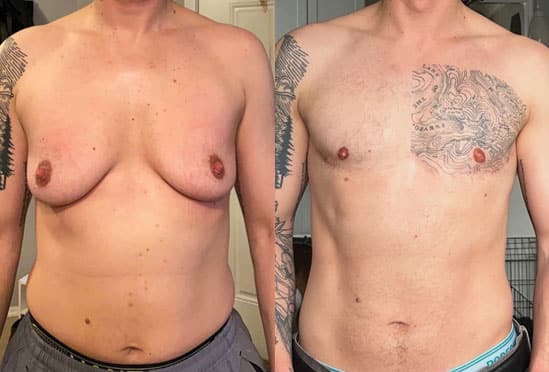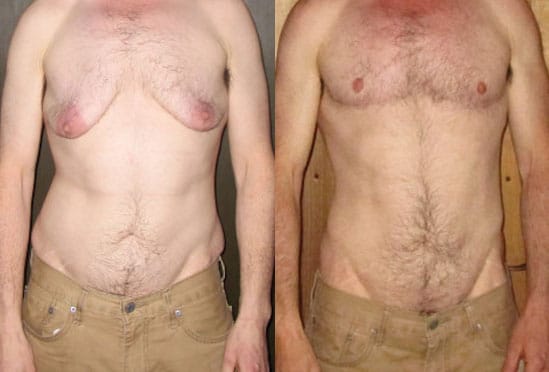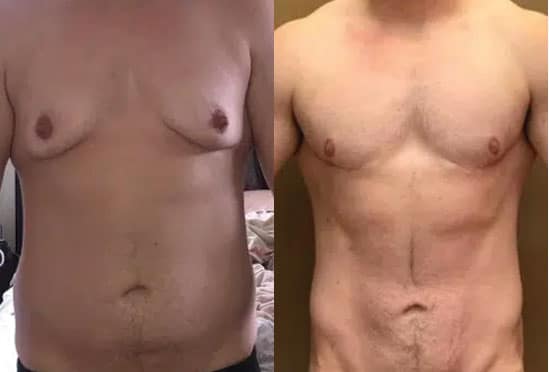Dr. Daniel A. Medalie in Cleveland, Ohio is an internationally recognized expert in the field of Female to Male gender affirmation chest or "top" surgery. He has been practicing since 1999 and has performed well over 3000 gender affirmation chest procedures. He has also published multiple articles and lectured extensively in the field of chest masculinization. He has been featured in several documentaries about transgender surgery including ones on MTV and LOGO tv. He also focuses on top surgery revisions and is happy to provide free virtual consultations for patients desiring another opinion or revisions of their previous top surgery.
IMPORTANT TOP SURGERY FAQs AND POST-OP INSTRUCTIONS ARE AT THE BOTTOM OF THIS PAGE-PLEASE SCROLL DOWN
*Plastic surgery results can vary.
What people are saying about Dr. Medalie on Google:
I'm a physician that specializes in the care of transgender people. I have seen hundreds of top surgery results over the years. Maybe even 1,000.
Dr. Medalie routinely produces the best results I see on any of my patients that get top surgery done. The worst outcome top surgery I have ever seen done by him was a 9/10. The best I've seen done locally in michigan I'd call an 8/10. Literally, the worst results I've seen on anyone done by this guy are better than the best results done by everyone else. Some of these patients come back and you can't even tell that they ever had top surgery done. I don't even know how he does the micro suturing or whatever it is that he does to not leave the telltale 1/2cm thick double incision scar lines but the results are amazing.
I have never talked to Dr. Medalie personally. I don't know him personally in any capacity or have any vested interest in his clinic or his success. This is my real honest opinion after eight years of treating transgender patients and seeing the results of the work of many surgeons.
Unequivocally he is my top recommendation for top surgery. It's not even close.
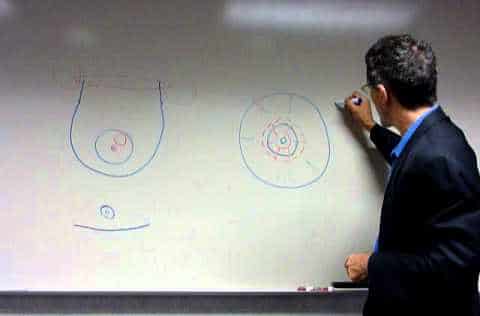
Dr. Medalie explains the various options for FtM Gender Affirmation Top Surgery
Dr. Medalie performs FtM Double Incision Mastectomy and Nipple Grafting

Dr. Medalie reviews his FtM top surgery results comparing the Peri to DI technique
FTM Top Surgery Double Incision with Nipple Grafts vs.Peri-Areolar Technique
| Aspect | FTM Top Surgery – Double Incision | FTM Top Surgery – Peri-Areolar |
|---|---|---|
| Definition | Chest masculinization procedure that removes breast tissue and excess skin through two horizontal incisions across the chest, with nipple-areola grafting or resizing. | Chest masculinization procedure performed through circular incisions around the areola, removing breast tissue with minimal skin excision. Can be partial (7-11 o'clock) or circumferential around the areola |
| Ideal Candidates | Trans men or non-binary individuals with medium-to-large chest size, excess skin, or reduced skin elasticity. | Best for small chest sizes (A–small B cup), minimal excess skin, and good skin elasticity. |
| Surgical Technique | Two incisions along the lower chest; breast tissue and skin removed; nipples resized and grafted in masculine position. Liposuction of central and lateral chest and pre-axilla. | Partial or concentric incisions around the areola; breast tissue removed; areola may be reduced; skin tightens naturally over time. Liposuction of pre-axilla |
| Scarring | Moderate to significant scars across the chest wall (fade over time but permanent). I try and place them in the shadow of the pectoralis muscle | Minimal scarring limited to the edge of the areola, often less visible. Can widen over time if circum-areolar |
| Nipple Sensation | Higher risk of loss of sensation due to free nipple grafting. | Greater chance of preserved nipple sensation since nipple is usually left attached. |
| Anesthesia & Surgery Time | General anesthesia; approx. 1.5-2 hours. | General anesthesia; approx. 2–2.5 hours. |
| Recovery Time | 4–6 weeks for most physical activity; no heavy lifting for 8 weeks, compression garments required for 2 weeks. | 4-6 weeks for most physical activity; no heavy lifting for 8 weeks, compression garments required for 2 weeks. |
| Risks & Complications | Bleeding, infection, nipple graft failure, contour irregularities, hypertrophic scarring. | Risk of skin wrinkling, nipple stretching, under-correction, or need for revision if excess skin remains. |
| Longevity of Results | Permanent, with possible revisions for scars or contour refinements. | Long-lasting, but higher chance of revision surgery if chest skin does not retract as expected. |
| Cosmetic Outcome | Creates a flat, masculine chest even with larger breast size, but with visible scars. | More natural-looking chest with minimal scarring; best cosmetic results only in small-chested patients. |
 Summary:
Summary:
When considering FTM top surgery, the choice between the double incision technique and the peri-areolar technique depends on chest size, skin elasticity, and desired outcomes. The double incision method is most effective for medium to large chests, providing a flat, masculine contour with permanent results, though it leaves visible chest scars and will almost certainly reduce nipple sensation. The peri-areolar approach, on the other hand, is best suited for individuals with smaller chests and good skin elasticity, offering subtle results with minimal scarring and a greater chance of preserved nipple sensation (but still variable). Both procedures significantly reduce gender dysphoria, improve self-confidence, and help trans men and non-binary individuals feel more comfortable in their bodies. Dr. Medalie is a world expert in gender affirmation top surgery and has been performing the procedure for over 25 years. He provides free virtual consults to prospective patients both for primary top surgery and revisionary top surgery.
Gender Affirmation Top Surgery- The Double Incision Technique
In those patients with a large amount of breast tissue with excessive skin of poor quality and droop, it is usually recommend to remove the excess skin and breast tissue in the crease of the pectoralis muscles (elliptical or double incision mastectomy) and put the nipples and areolae back on as grafts. This surgery has the advantage of immediate and predictable results. I can contour the skin flaps and place the nipples where I want to. It has the disadvantage of permanently altering the sensation and erectile capacity of the nipples (and sometimes the pigmentation), and it leaves larger scars on the chest. Over time they fade and flatten out. At each end of the scar, “dog-ears” may form. These are small bunches of tissue created by the closing of the ellipse as a straight line. They tend to settle down over time, but may need to be revised. I always try and address the dog ears at the time of surgery but this may extend the length of the scar. Dog ears are more likely in patients who are heavier and have more tissue to start with. I always perform liposuction of the central and lateral chest (to flatten the dog ears) as well as the area in front of the armpit (pre-axillary fat pad). I have been asked why a scar may meet in the center of the chest on some top surgery results but not on others. This is dependent on pre-existing anatomy. If the tissue meets in the middle then the scar by necessity will meet in the middle. In general my goal with the DI is to leave a scar that is straight in the midline and then angles up laterally on the edge of the pectoralis major muscle. If the patient subsequently works out the chest muscle, over time, the scar will be hidden in the shadow of the muscle. This can be seen in multiple patient photos in my Top Surgery Gallery
*I have patients that ask to opt out of having the nipple grafts and consider just getting tattoos. This is something that I am unwilling to do. Nipples are part of the normal human anatomy and I am only comfortable performing surgery to create natural results. Additionally the nipple/areolar complex is unique and can’t be reconstructed once thrown away*.
DOUBLE INCISION SURGERY STEPS:
- Marks drawn on chest in OR holding area, IV placed, and patient taken back to OR and put to sleep under light general anesthesia.
- Tumescent solution (saline, local anesthesia and epinephrine to constrict blood vessels) infiltrated into the chest and breast.
- Incisions marked and nipple/areolar grafts harvested and placed in sterile container. If the nipple is too large, it and the areola are taken as separate grafts.
- Power assisted liposuction (PAL) performed in central chest, pre-axillary region (in front of armpits) and lateral to breast tissue.
- Flap of chest skin and fat elevated off underlying gland and gland removed from pectoralis major and chest wall with electrocautery (controls bleeding).
- Drains placed in wound and long lasting local infiltrated into pectoral nerves, and the skin is temporarily closed with surgical staples.
- The patient is sat up and assessed for incision symmetry. Corrections are made if necessary.
- The incisions are closed with a triple layer of absorbable sutures.
- The patient is sat up again and new nipple positions are measured and marked with a cookie cutter (typically 23-25 mm in diameter). The patient is sat down.
- These areas are de-epithelialized (skin is removed but underlying dermis remains).
- The nipple/areolar complex is thinned to improve survival of grafts and then sewn onto prepared site (Either as one piece or separate grafts within grafts)
- Occlusive dressings, foam and a compression vest are applied.
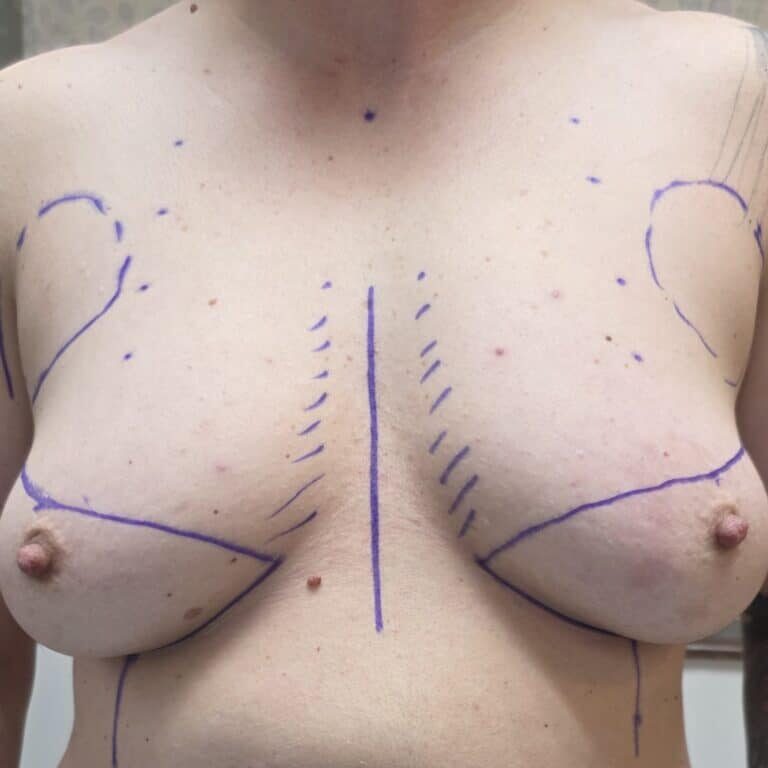
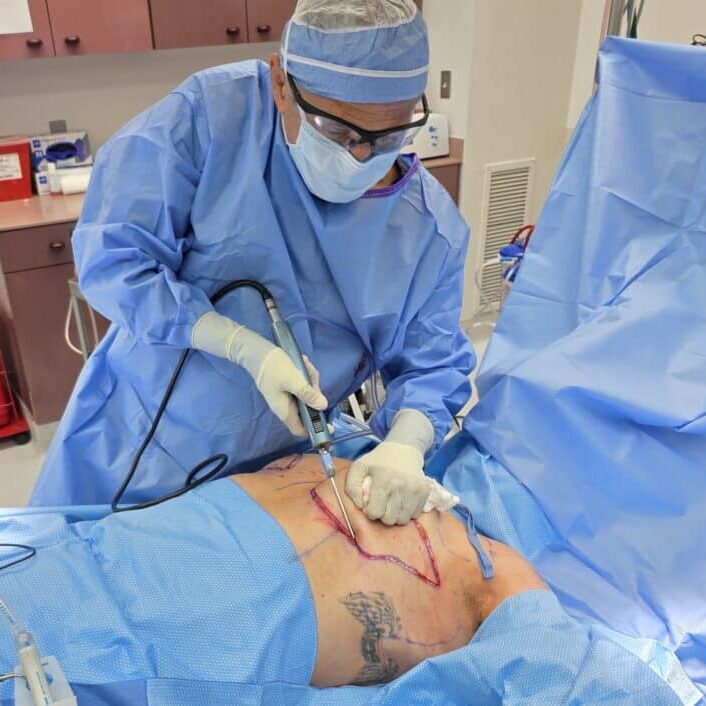
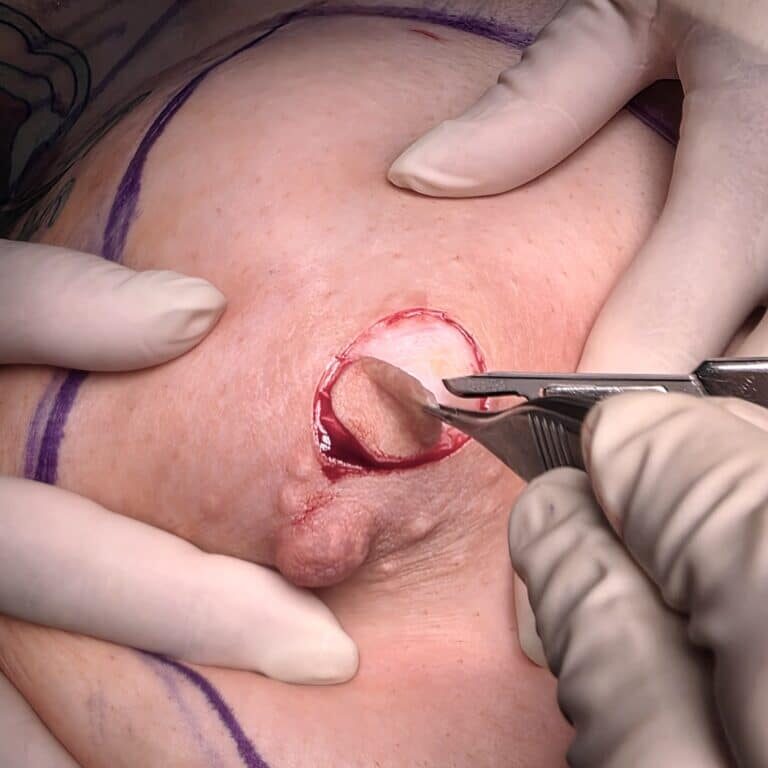
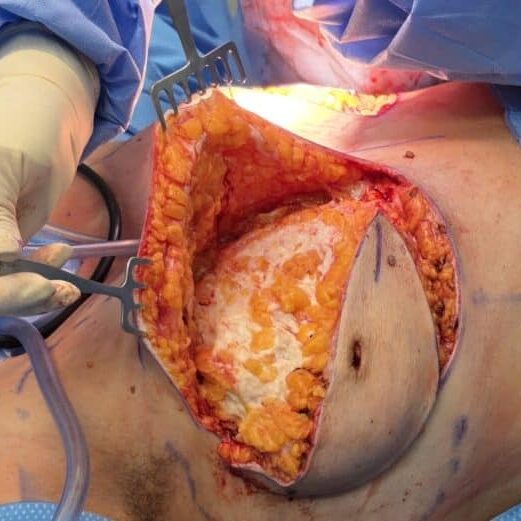
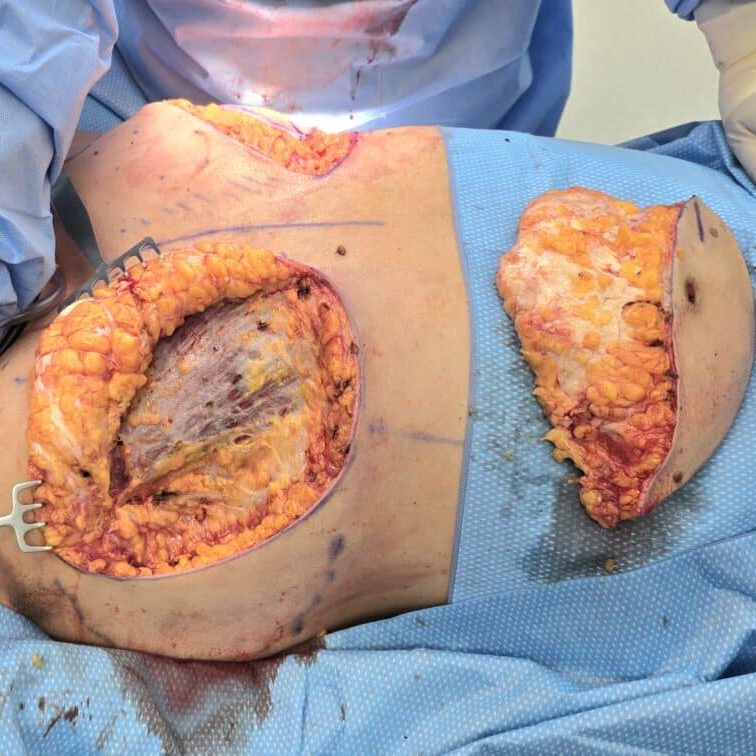
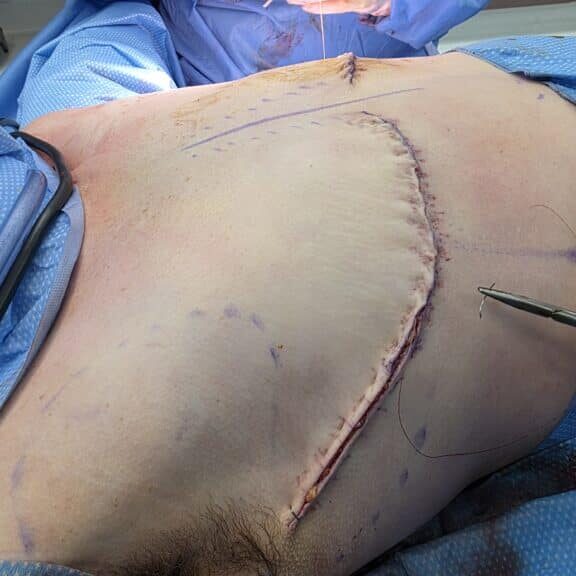
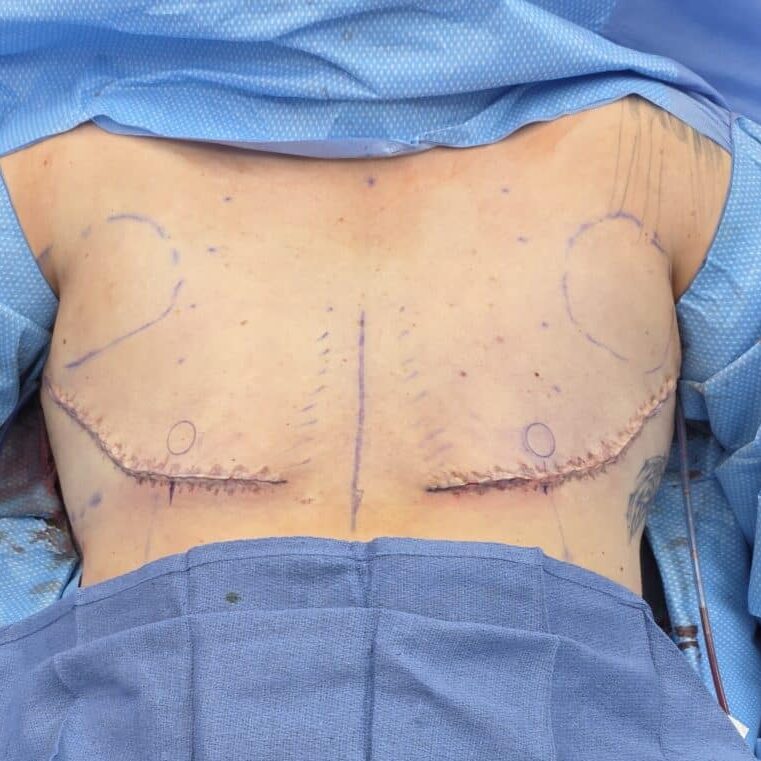
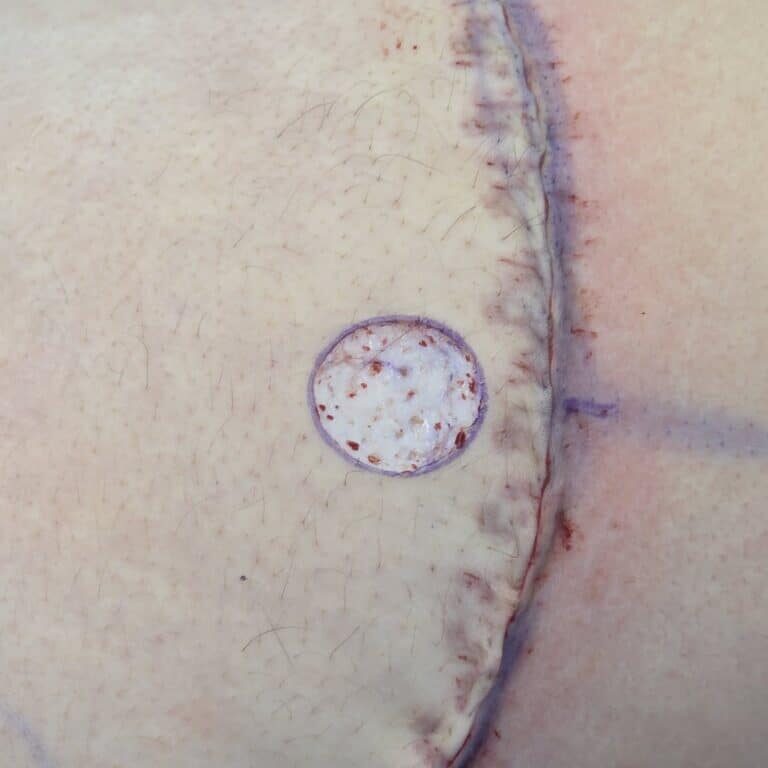
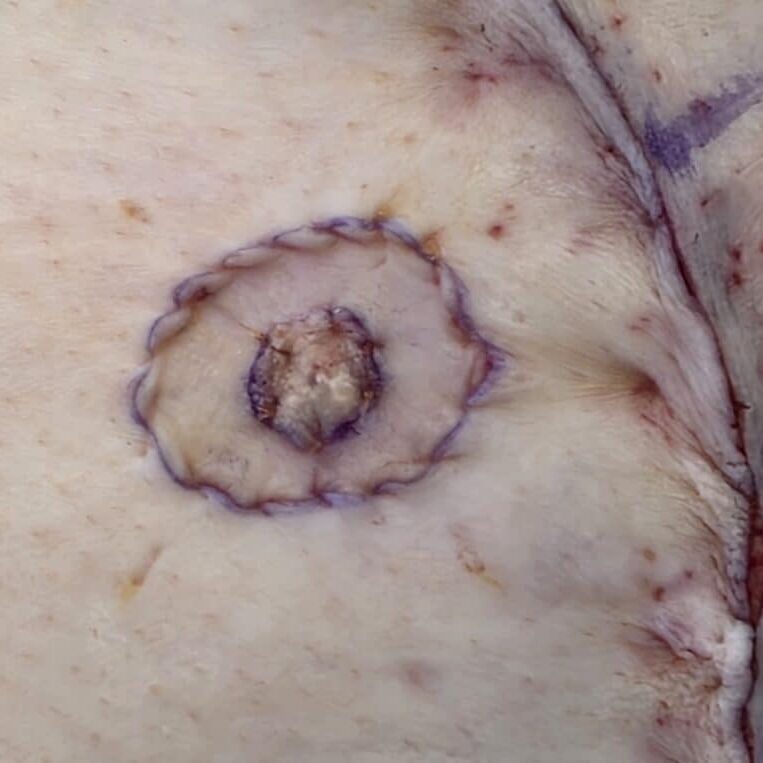
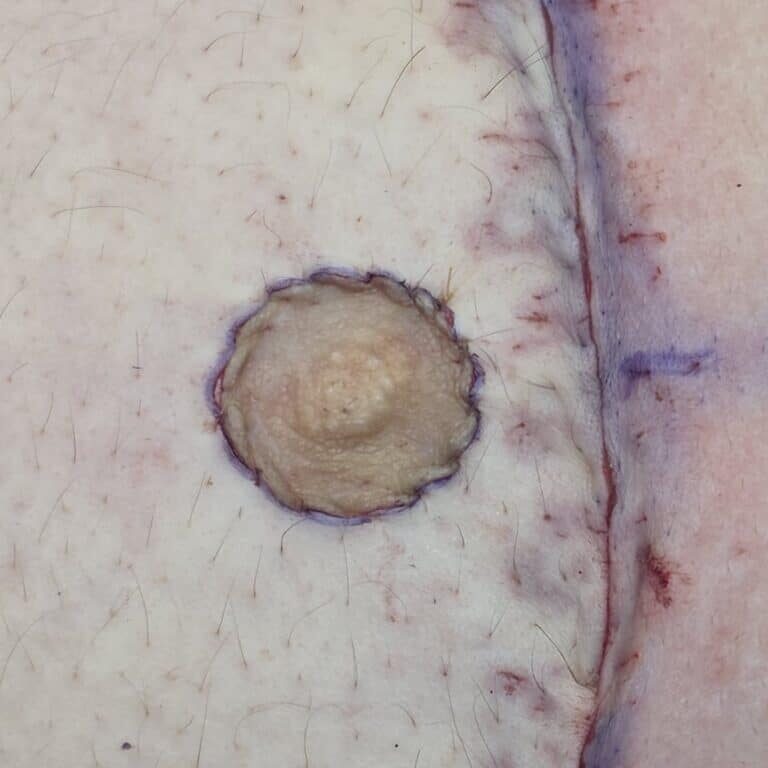
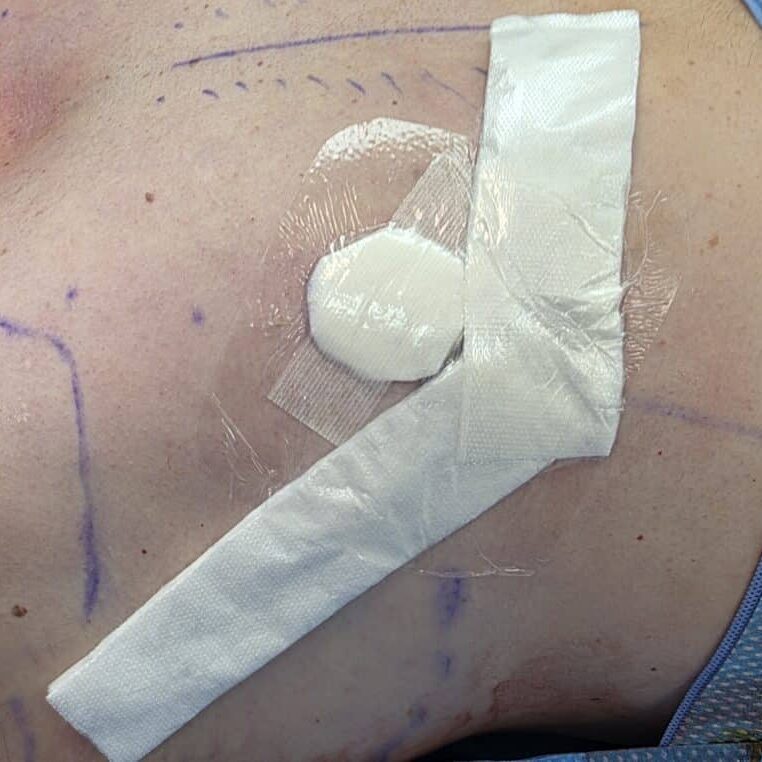
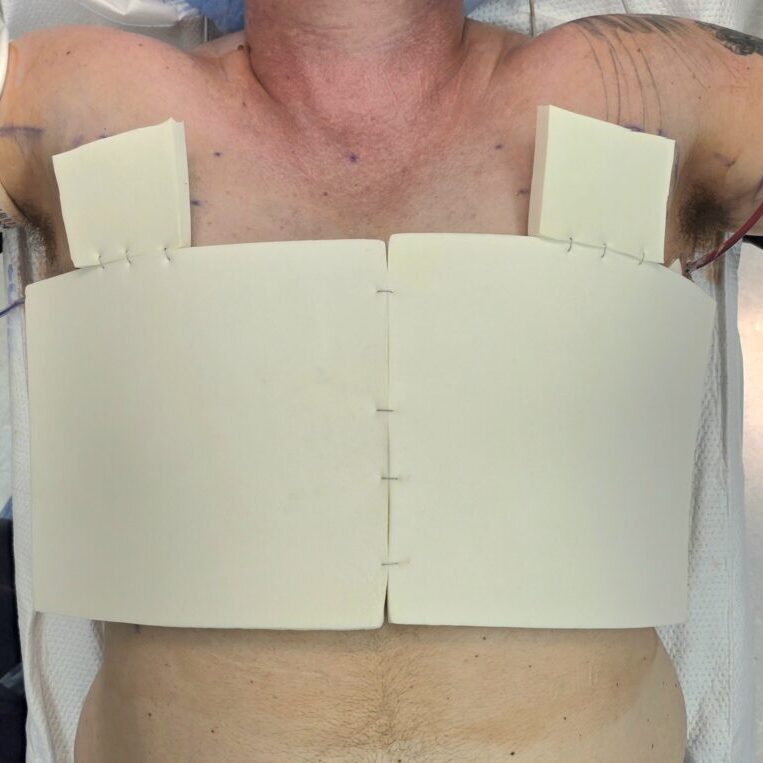
Other Procedures for FtM DI Patients-Liposuction, Body Contouring
Many patients ask whether other procedures can be performed concurrently with the top surgery. The most common procedure asked about is liposuction of the flanks, hips, abdomen and thighs. I do this frequently to help contour the whole trunk and would be happy to discuss this with any prospective patient. Please include the whole trunk (front and back) in the photos sent to me so that I can effectively evaluate you. The cost is variable and depends on the extent of extra liposuction performed and the anticipated time that it will take. To see some of my typical results for liposuction and body contouring, please Click Here.
Below is a patient who requested top surgery and body contouring. Because of the loose skin of his chest he was only a god candidate for the double incision procedure with nipple grafting. In regards to his torso, I felt that with liposuction alone he would have a reasonable result but possibly some retained skin laxity in the lower abdomen. He thus elected to have a lower abdominoplasty in conjunction with his liposuction procedure. This enabled me to tighten his loose skin after aggressive body contouring with power assisted liposuction. He has also been engaged in extensive physical conditioning since the surgery!
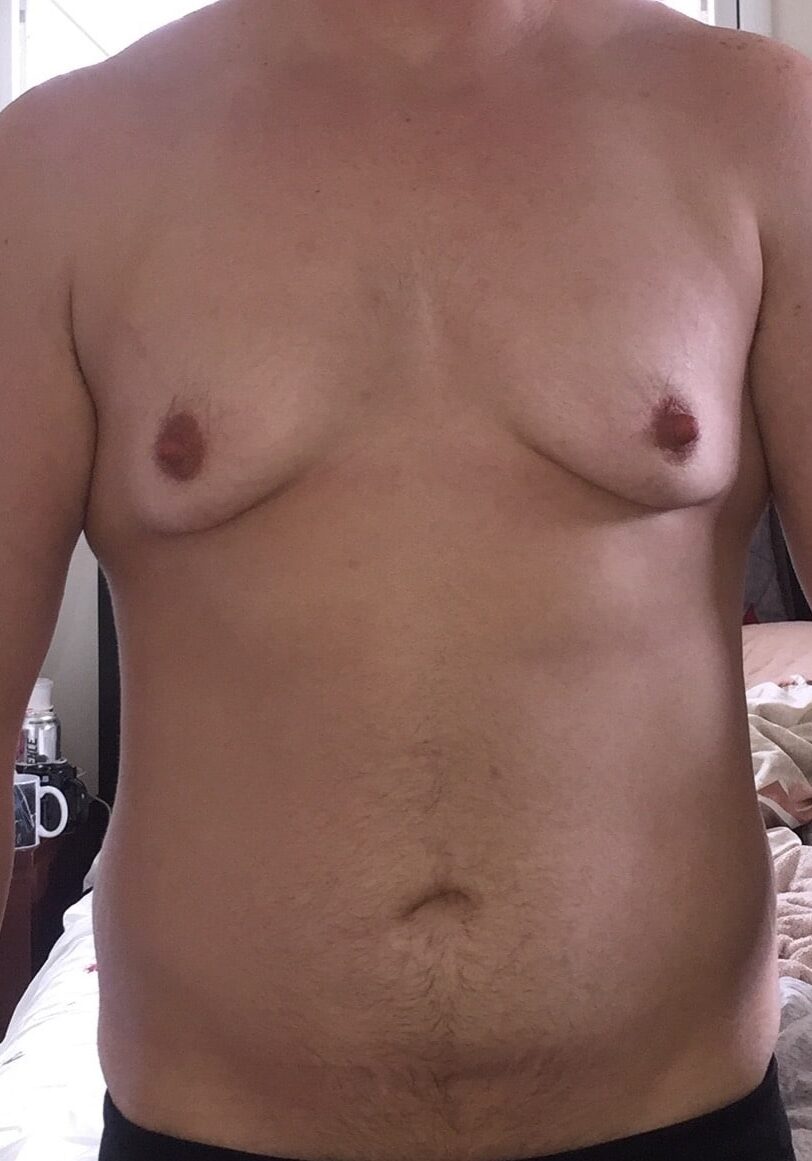
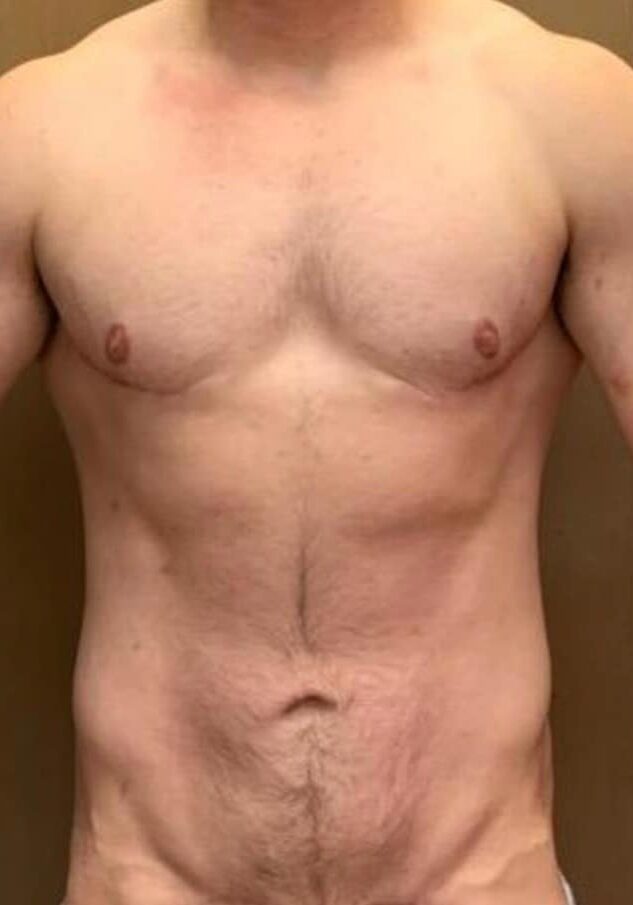
FtM Double Incision FAQ
Yes-The DI procedure needs to be performed with the patient asleep.
A typical Di takes around 1.5 to 2 hours. This includes the mastectomy, nipple grafts and chest liposuction.
I typically give my patients antibiotics on the day of surgery. Post operative infections are rare and are typically related to the dissolving sutures which can sometimes irritate the skin. Please be aware that smoking is the number one reason for post-operative infections and healing problems. I thus require my patients to STOP SMOKING at least 3 months prior to top surgery procedures.
During the surgery, local anesthetic is injected into the tissue using a tumescent technique-this blocks the sensation and also constricts blood vessels. As a result, there is very little bleeding during the surgery. I have NEVER had a patient have a severe bleeding complication post-op, but it is not impossible and a return trip to the OR may be necessary. No one has ever needed a blood transfusion for this procedure. Sometimes a patient will get a little bit of bleeding in the chest and not know it because of all of the dressings. This is called a hematoma and can be addressed under local in my clinic without a return to the OR.
The shape of the scars and whether they meet in the middle is dependent on your pre-existing anatomy. If the breast tissue meets in the middle or is very close then probably the scars will meet as well. Over time as the scars fade this is not very visible.
I have performed literally thousands of DIs and nipple grafts and find that the grafts almost always do well. Sometimes there is some scabby or delayed healing but over time the results end up the same. Patients with darker skin can have some de-pigmentation of the grafts which will fill in over time. Sometimes there remain de-pigmented spots, and I recommend tattooing. Occasionally small hair follicles cause cysts under the grafts which can be annoying but are not dangerous. This is almost always self-limiting and will resolve with warm soaks and antibiotic ointment. Because the nipples are completely removed from the body, by necessity nerves are cut and this will permanently alter the sensation and erectile capacity of the nipples.
These are fairly well tolerated operations. Pain that may require narcotic pain medicine typically lasts 3-4 days. After that, ibuprofen (Motrin and Advil) is sufficient. I recommend that patients take at least 1 week off from work or school and driving. The post-op care involves a compression vest for 2 weeks and scar massage after that. No heavy lifting is allowed for 8 weeks Most of the swelling and all of the buried stitches have disappeared by 3-4 months.
I recommend that patients refrain from exercise for at least 3 weeks after surgery. Even after 3 weeks, the incisions may be sensitive and patients need to use caution. Full activity including heavy lifting can not resume until the patient is 2 months out from surgery.
Some of the deep sutures under the skin can take up to three months to completely dissolve. For this reason, some patients may report sensitivity issues such as itching for up to three months post-op. Nipple and chest sensation may always be a little numb. Typically my patients have resumed full activity by 2-3 months. The final result including fading of the top surgery scars can take up to 1 year.
Yes – I frequently perform multiple procedures on top surgery patients. Liposuction and tummy tucks are the most common simultaneous surgeries.
The cost of top surgery varies based on:
- Surgical technique required (peri-areolar vs. DI)
- Duration of the procedure
When you consult with Dr. Medalie he will explain your options and e-mail you a comprehensive price quote the same day that includes the top surgery, the anesthesia and the facility costs. A typical DI costs around $8000-9000 depending on the size of the patient.
